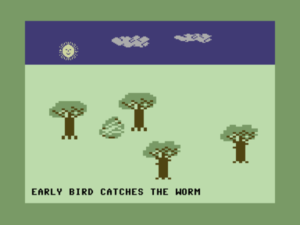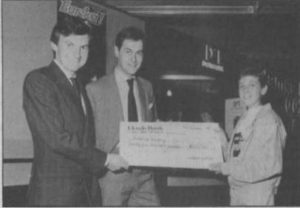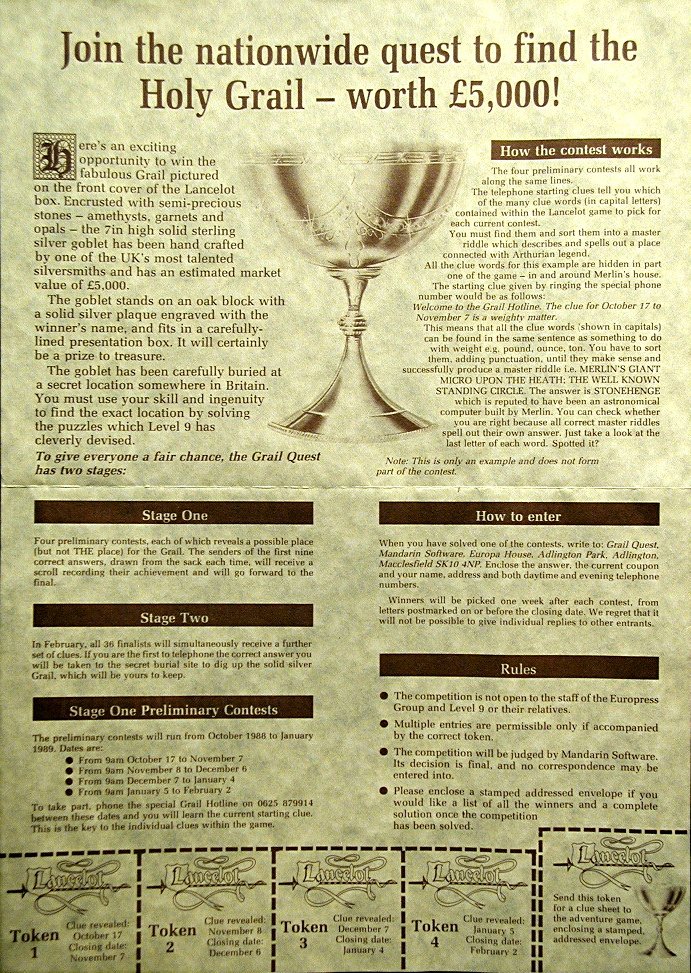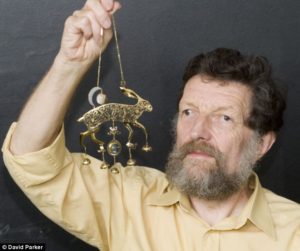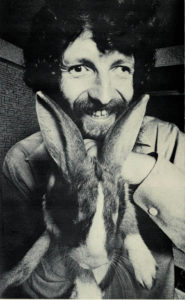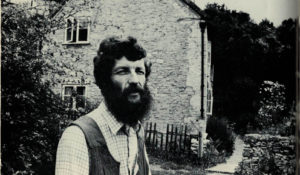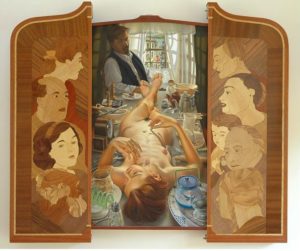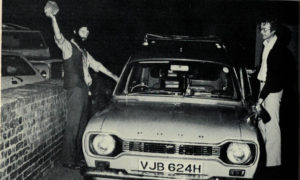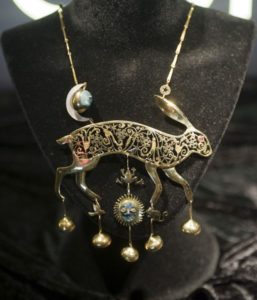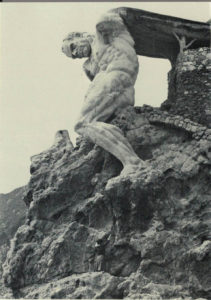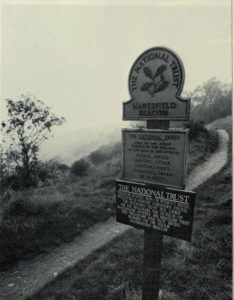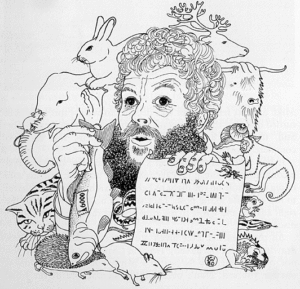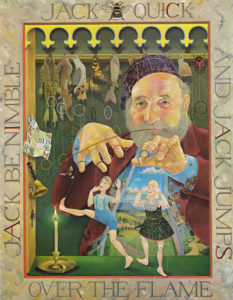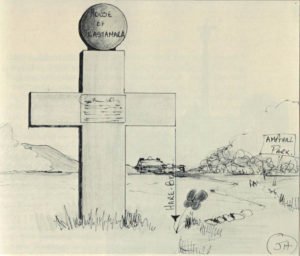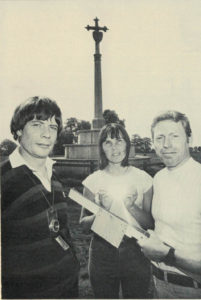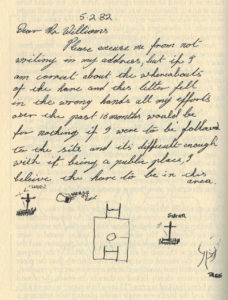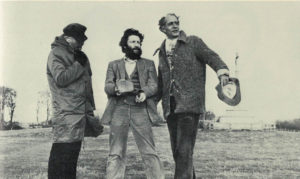One day lagomania gripped Britain; the next the hare had been discovered and it was all over except the ennui. The television segments and newspaper articles ceased almost as quickly as the charter tours and the book signings. Rod Argent’s Masquerade musical, which had been all set to make the jump from the Young Vic to the West End, went from a packed house to an empty one overnight, and closed within two weeks. Kit Williams shelved his merry-leprechaun persona and went back to his painting. Tom Maschler and his publicity machine at Jonathan Cape gnashed their teeth at their uncooperative, unappealingly anonymous winner, who had spoiled their plans for making this moment a climax rather than an anticlimax, and in the process cost them the chance to turn Masquerade into an ongoing series of similar grand public treasure hunts. As it was, the public’s appetite for this sort of fare seemed permanently spoiled by the bad taste “Ken Thomas” had left in its mouth.
Instead another craze began to sweep through Britain. Just weeks after Masquerade wound up, the Sinclair Spectrum and the BBC Micro started shipping in quantity to British consumers, transforming what had been a burgeoning underground hobby into a full-blown mainstream craze for computers and especially computer games. By 1984, British per-capita computer ownership had exceeded that of the United States, marking it as the most computer-mad nation on earth. It was in connection with this latest craze for computers, barely a glint in a few dreamers’ eyes when Kit Williams had fashioned the golden hare five years before, that the treasure unexpectedly reemerged from the bank vault into which Ken Thomas had stuck it.
News of a company called Haresoft first arrived in the June 5, 1984, issue of Home Computing Weekly. (Yes, Britain was so computer-mad that it could support a weekly magazine for enthusiasts — in fact, two of them.) Thanks to an “exclusive arrangement,” the magazine offered readers a chance to buy something called Hareraiser Prelude for most major platforms directly from Haresoft before it shipped to stores. The announcement marked the beginning of a new hunt for the hare. Or, if the winner preferred, she could take £30,000 in cash in lieu of the hare — that being, according to Haresoft, its estimated value as a piece of art and a cultural touchstone after all of the Masquerade excitement. The hare wasn’t actually buried this time, “to avoid damaging the countryside and to give an equal chance to young people who cannot travel freely.” All you needed to find it in virtual space was “patience and an inquisitive mind” for a puzzle “that could be solved by adult and child alike.” But doing so wouldn’t be cheap. Would-be winners would have to purchase not only Hareraiser Prelude but also Hareraiser Finale to divine the hare’s new location, each for the princely sum of £8.95, a premium price point normally reserved for only the most desirable and ambitious games.
The division into a Prelude and a Finale did rather leave one wondering where the meaty middle had gone. Those punters foolish enough to fork over the money were given yet more cause to wonder. “I find all my feelings of eager anticipation suddenly turned to shock and desolation,” wrote one earnest treasure hunter who’d convinced herself she was about to embark on a new Masquerade. What she got instead was something much, much shabbier.
A remarkably threadbare product even for an era when ramshackle junk was the rule rather than the exception, the Hareraiser “games” are as ugly as they are inscrutable; at least Masquerade gave you some lovely pictures to look at while you pored hopelessly over its puzzle. A handful of kilobytes of code — the Prelude and Finale together could fit into the memory of a 16 K Sinclair Spectrum — depict a crudely drawn landscape made up of ground, trees, sky, clouds, and sun, all executed with the stick-figure flair of an ungifted three-year-old. The opening text says you can move around this space with the cursor keys, but if there is any logic to the geography at all it must be that of a giant text-adventure-style maze. Assuming you can judge your location from the number and positions of the trees (perhaps a dangerous assumption), moving north and then south doesn’t return you to your starting point. Occasionally, according to no detectable rhyme or reason, a hare runs across the screen, thus providing the sum total of the action. The only other element is an occasional cliché that pops up at the bottom: “Use your brain”; “Can you see the wood for the trees”; “Early bird catches the worm.”
All Haresoft correspondence was conducted by someone calling himself “Jeff Lubbock,” who may or may not have actually existed. Lubbock’s official line was that Ken Thomas had sold the hare to his company for £20,000, but said company’s behavior bore lots of suspicious similarities to Thomas’s own immediately after winning the hare. Haresoft hungered after notoriety, the better to sell more copies of Hareraiser, yet hid behind a cloak of anonymity at the same time, conducting all business and public relations solely via press releases and advertisements. Although Home Computing Weekly had been fooled into lending some of their credibility to Haresoft at the outset, the company would never again be accorded that sort of respect. The young men writing for the laddish gaming magazines with titles like Crash and Zzap! may not have been the most nuanced of critics, but even they had little trouble sniffing the odor of disreputability that fairly poured out of Haresoft. For one thing, the numbers just didn’t add up. “Where will it all come from?” wrote Computer and Video Games of the £30,000 prize in their review. “Suppose £1 per game is put into a kitty — that’s one helluva lot of copies to hope to sell for a puzzle that isn’t even a game!” Sinclair User was equally direct: “It is rather difficult to understand why this program was produced at all, though cynics may draw their own conclusions.”
Poor reviews turned to outright snubs between the first and second Hareraiser; virtually no one even bothered to review or even announce the availability of the Finale when it appeared a few months after the Prelude. Just as well, as it was effectively indistinguishable from the Prelude anyway. As Haresoft’s press releases and advertisements grew ever more strident in light of what must have been nearly nonexistent sales, dismissal turned to open scorn. Sinclair User jeered at Haresoft’s non sequitur of a claim that they had released Hareraiser in two parts “to make it fun and enable competitors of all ages to participate”: “Bet you thought it was just a way to make more money.” A claim that Hareraiser was being bought by schools “to involve pupils in developing computer-logic skills” prompted a little investigative reporting. “We couldn’t make an awful lot of sense of it,” said one of the few headmasters who would admit to having bought the programs. “I think most schools bought Hareraiser to try and win the £30,000 for their school. That’s certainly why we had a look at it.” So much for “developing computer-logic skills.” The most bizarre of all the Haresoft press releases claimed that Anneka Rice, host of a hugely popular game show called Treasure Hunt that also owed more than a little something to Masquerade, had revealed a clue to the puzzle when making a live appearance at Harrod’s. Since the appearance hadn’t been filmed, apparently the clue could only be useful to those who coincidentally happened to be at the event and retained a perfect memory of every word Rice had said there.
The question of whether there ever was a real solution to the alleged puzzle of Hareraiser is, like so many questions surrounding Kit Williams’s golden hare, impossible to fully answer. Disassembling the programs to look for a solution, as a commenter here recently suggested, is a nonstarter, as there is no “winning” screen, no opportunity to solve the puzzle on the computer and have the program acknowledge your achievement. You’re rather expected to solve it on pencil and paper using clues from the programs. It’s possible that a puzzle of some sort was created in good faith, but was so horrid no one ever had the ghost of a chance of figuring it out. Still, not building a winning state into the program itself did allow Haresoft to arbitrarily declare the solution to be whatever they wished it to be — and whenever they wished to do so. Indeed, if I had to guess I’d say that here we come to the real plan, such as it was. If Hareraiser took off to become another sensation like Masquerade, Haresoft would have the flexibility to bend the solution to a winner chosen at whatever juncture best maximized the publicity and the profit.
But, in an affirmation of the good sense of the British computing public, Hareraiser didn’t become another Masquerade. The whole thing was so tawdry, so obviously shady, that almost no one bought in. A desperate Haresoft was reduced to creating painfully transparent sock puppets to write in to the magazines who were savaging the programs.
I wonder who these nerds are who think this isn’t any good. I am one of a group of six who have had immense fun from seeking clues on this treasure hunt, and furthermore, it’s not meant to be a book like Masquerade. If one seeks to win the golden hare, the computer gives the clues, the rest is down to you — that is, if you’re intelligent enough.
This testimony from “Mrs. Widdowson” helped not a whit. Haresoft quietly disappeared during the early months of 1985, leaving behind no forwarding address and not a peep about the still winnerless contest.
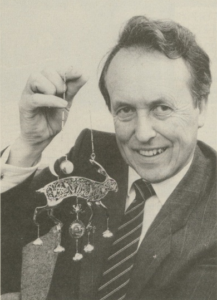
Dennis Cross, the court-appointed liquidator of Haresoft, shows off the golden hare shortly before it was auctioned off.
But the wheels of bankruptcy do grind, slowly yet relentlessly. In December of 1988, a month of bombshell revelations about Masquerade, the golden hare, and Ken Thomas, Kit Williams’s treasure resurfaced for auction at Sotheby’s. The court-appointed liquidator of Haresoft, charged with recovering as much money as possible to pay off the bank that had been unwise enough to supply the operation’s seed capital, had found the defunct company’s one asset of any real value to be the hare, and had promptly seized it to auction it off. The auction turned into a media circus, at last providing the big star turn for the hare that Tom Maschler’s publicity machine had planned for the original unveiling. Caron Keating, known among children as host of the television show Blue Peter and among adults as something of a sex symbol, did the hosting honors, wearing the hare around her neck as the ultimate fashion accessory. Kit Williams himself was there to bid for the hare, but had to drop out at £6000. It was finally sold for £31,900 to an anonymous buyer, shocking everyone; everyone had assumed that the estimated worth of £30,000 was, like most things to come out of Haresoft, complete nonsense. The auction put the capstone on the hare’s first checkered and very public decade of existence. Henceforth it would lead a quieter life, winding up in a private collection in Asia. It would be more than twenty years before it would enter the public eye again.
The same month of December 1988 brought a certain vindication to everyone who had witnessed the disappointing ending of the original hunt for the hare, for in the course of this month Ken Thomas’s cherished cloak of anonymity was finally stripped away and many of the details of the cheating everyone had always suspected him of were finally laid bare. The news broke nationwide in The Times of December 11, 1988, just six days after the hare had been sold at auction. But the real legwork had been done by the editor of the local Bedfordshire newspaper, Bedfordshire on Sunday, published near the hare’s burial place in Ampthill Park.
Frank Branston, the editor in question, had first become involved with the story about a year before the hare was dug up, when a local man named John Guard told him out of the blue that he thought he knew where to find it. When Branston queried how he had come by this information, Guard replied that his girlfriend, Veronica Roberts — more commonly called “Ronnie” — had been Kit Williams’s girlfriend at the time he was creating Masquerade.
Guard wasn’t the most reliable of witnesses. A heavy drinker and heavy pot smoker, he had a reputation as a small-time con artist and general ne’er-do-well around town, prone to regular flights of fancy not too different from this claim. But Branston was able to confirm that at least part of his story was true: Ronnie Roberts had indeed been the girlfriend of Kit Williams a few years before. For months, whenever Branston would see Guard around town, he’d quietly ask him about the hare, whereupon Guard would reply only that finding it was proving more difficult than anticipated. When the treasure was finally found right there in Bedfordshire, allegedly because someone’s dog chose to pee on the Ampthill Park monument, Branston immediately thought again of Guard. He tracked him down to ask him directly if he was the mysterious Ken Thomas. Guard replied in the negative, albeit in a suspiciously evasive manner. Branston soon had confirmation that Guard couldn’t be Thomas; one look at the pictures of Thomas at the unveiling of the hare was enough, even disguised as he was, to confirm that he wasn’t Guard.
And yet Branston’s suspicions remained. He launched a modest investigation into Thomas’s identity. A bit of research revealed that the solicitor Thomas was using as representation for his negotiations with Jonathan Cape was a local Bedfordshire man. That meant that Thomas was almost certainly a local as well, further raising Branston’s suspicions about a possible connection with Guard. After this, though, he drew a blank. He couldn’t shake anything else loose from Guard, the solicitor, or any of his contacts covering the story in the national media. And so for the next six years he left it at that.
Branston’s curiosity was revived in 1988 when a brief blurb came across his news wire stating that the golden hare of Masquerade was to be sold at auction as part of the liquidation of a company called Haresoft. It was easy enough to check the official records and see who was behind Haresoft. The founder and head was listed as one Dugald Thompson, living in the Bedfordshire village of Bolnhurst, close by Bedford and Ampthill. And the records showed something else: Thompson was also associated with a brief-lived wishful thought of a company called Clayprint, set up by none other than John Guard. Branston had his connection at last. To keep the two men from concocting a story together, he went out to see Guard at the same time that one of his reporters visited Thompson. After the pair had done a fair amount of wriggling on the hook, a story emerged, largely from Guard rather than the steadfastly uncooperative Thompson, that sounded like at least the partial truth.
Ronnie Roberts had indeed first agreed to tell John Guard what she knew about the hare about a year before its eventual discovery, prompting him to crow about it to Branston and quite possibly others around town. But, being something of a hippie idealist, she would share only on the condition that the proceeds from its finding and presumed sale be donated to animals-rights organizations. Guard readily agreed to this proviso at the time; whether he ever intended to honor it is yet another of those insoluble Masquerade mysteries.
Roberts knew quite a lot, although perhaps not quite as much as she thought she did. She had gone out to Ampthill Park with Kit Williams to have a picnic there one spring equinox, in the midst of which he’d excused himself to go bury a magnet marking the future position of the hare. Yet Williams hadn’t been entirely trusting; he’d made sure she didn’t see the exact spot. Her understanding of the burial location was garbled and incomplete. She knew it had something to do with the position of the memorial’s shadow on the spring equinox, but believed the hare to be buried immediately adjacent to the memorial rather than at the full extent of the shadow. Still, she did know it was in Ampthill Park, which was far more than anyone else knew at the time.
Looking for a further leg up on the search, Guard approached a local metal-detector enthusiast named Eric Compton with Roberts’s information. There was £1000 in it for him, Guard said, if he would bring his gadget out to Ampthill Park and help him find the hare — and, just as importantly, if he would act as the front man for their little conspiracy afterward. Guard knew that his connection to Roberts, and Roberts’s connection in turn to Kit Williams, must come out as soon as he personally tried to claim the prize, and then the jig would be up.
But as it happened, the conspiracy never got that far. Many nights of tiresome late-night digging and metal-detecting close by the memorial, where Roberts believed the hare to be buried, revealed nothing. After a final assault on the actual day of the spring equinox of 1981 had also proved fruitless, Compton begged off in disgust, convinced he’d been suckered into yet another of Guard’s groundless flights of fancy.
That would seem to have marked the end of digging at Ampthill Park for many months, until the physics teachers Mike Barker and John Rousseau hit upon the solution to the puzzle and the precise location of the hare that had so eluded Guard and Compton. The “slight depression” Barker took as worrisome evidence of previous digging when he arrived at Ampthill Park on February 18, 1982, was likely the remnant of Guard and Compton’s efforts, now almost a year old. (The story that “Ken Thomas” told of digging immediately before Barker is, like most of what he said, almost certainly total nonsense.)
And so we come to the crazy final days of the treasure hunt, where we’re sadly cast back into the realm of the unknown and possibly unknowable. We know that John Guard was acquainted with Dugald Thompson, and must have told him about Ampthill Park. We know as well that it was Dugald Thompson who became Ken Thomas. What we don’t know is what sort of arrangement, if any, the two men arrived at. Was Thompson Guard’s new front man, Compton’s replacement in the role? If so, the plan to sell the hare and donate the proceeds to animal-rights charities evidently fell by the wayside in favor of using it to start a shady software company. Still, a partnership of the two men would explain the identity of the mysterious friend Thompson mentioned digging with him on the last day, when the hare was finally found. The other possibility is that Thompson snookered the would-be snookerer, taking Guard’s information and acting on it unilaterally. It’s not as if Guard would have been in any position to come forward with his grievance.
One eyebrow-raising coincidence about the final days of the hunt does seem to be just that: Thompson’s posting his letter to Kit Williams just one day before Mike Barker arrived at Ampthill Park for his own dig. Whether acting alone or in partnership with Guard, Thompson decided to try to win the prize for himself without actually digging up the hare first, through this vague letter that implied he knew more than he did. He had done enough research to realize that, with Ampthill Park lying almost directly on the Greenwich meridian, the memorial’s shadow would be cast directly northward on the spring equinox. He didn’t, however, reckon with the difference between magnetic north and true north, diagramming the former rather than the latter in his letter. It was Barker’s enormous misfortune to have done his digging just as Thompson, with or without Guard, was also nosing around. In combination with some ill-advised hints dropped by Kit Williams in their phone conversation, that was enough to put Thompson on the correct track.
That chain of conjecture, at any rate, seems likely to be the best we’ll ever be able to do. John Guard died some years ago, “of drink and drugs” according to Frank Branston, while Ronnie Roberts vanished without a trace. Eric Compton still lives in Bedfordshire, but has no real knowledge of what might have gone on between Thompson and Guard. Dugald Thompson himself, the shadowy man at the center of the mystery and the one person who certainly knows the entirety of what really happened, was still with us when contacted by the BBC in 2009, but remained as stubborn and patently dishonest as ever. Among other things, he claimed that he found the hare entirely on his own — the connection to Guard and Roberts being just another coincidence — but can’t tell the true story “for legal reasons” (one suspects that the latter statement may in fact be true). He also claims that the idea of the “Ken Thomas” persona was actually concocted by Tom Maschler and Jonathan Cape, a claim contradicted by absolutely everyone else.
So, that’s your dose of scandal and conspiracy for today, the sexy part of the Masquerade story. The real reason I wanted to write these articles, however, has little to do with the contest’s juicy ending, fun as it may be to speculate about. Masquerade, you see, cast an enormous shadow over the computer-game industry that exploded in the years immediately after the contest’s conclusion — a shadow that extended far beyond the tawdry story of Haresoft and Hareraiser. It was only natural for marketers looking to drum up excitement for their games to cast their eyes back to a contest that had just sold more than a million books. And look back they did. For some years British gaming especially was a riot of Masquerade-inspired contests.
Which isn’t to say that the United States was entirely bereft of digital Masquerades. On the contrary, arguably the most slavish digital clone of all, an interactive “children’s storybook” containing clues to the locations of three “solid gold, gem-encrusted” keys hidden in three separate locations in the United States, was a late 1982 American title called Prism from International Software Marketing. I’ve been unable to find any evidence that any of the keys were ever found, unsurprisingly as it seems that very few ever bought the software; International Software Marketing disappeared within a year. After that, Masquerade‘s influence in the United States, while far from negligible, tended to be more oblique, living in the realms of aesthetics and game design rather than public contests. Most notably, Cliff Johnson’s fairy-tale puzzler The Fool’s Errand was heavily inspired by Kit Williams’s book, although Johnson wisely made his storybook much more soluble. One of the loveliest games of its era, The Fool’s Errand makes a magnificent legacy for the golden hare all by itself.
But in Britain the influence of Masquerade was far more sustained, obvious, and direct. As with the example of Prism in the United States, it tended to be the earliest of the British Masquerade heirs that tried to translate the experience of the earlier treasure hunt most literally. Just months after the hare was dug up, the merry pranksters at Automata introduced a text adventure called Pimania, containing clues to the location of the Golden Sundial of Pi, a much tackier-looking treasure than Kit Williams’s hare but one worth — according at least to Automata — £6000. It wouldn’t finally be discovered until July of 1985, an event that marked the brief-lived Automata’s last hurrah.
I don’t know of any others who actually buried a treasure, but similar trinkets were a definite order of the day as contest prizes for some time. For instance, the first person to solve Castle of Riddles, Peter Killworth’s second published text adventure, received £1500 in cash and a “£700 hallmarked silver ring-shaped trophy mounted on a presentation plinth and inscribed ‘King of the Ring.’”
But publishers soon realized that elaborate objets d’art weren’t really necessary for a rousing contest. Cold, hard cash would do just as well or better. The race toward ever larger jackpots reached its dizzying climax with a 1984 game from Domark called Eureka!, a huge production for the time consisting of five separate text adventures, five action games, and a hardcopy poor man’s Masquerade, or “Book of Riddles,” all allegedly designed by Ian Livingstone of Fighting Fantasy gamebook fame. The collection as a whole was a monument to quantity over quality, but the prize for being the first to slog through it all was nothing to sneeze at: £25,000 in cash, the largest of these sorts of prizes ever awarded (as opposed to merely promised in the case of the benighted Haresoft). The winner, who didn’t emerge until the game had been on the market for more than a year and the contest’s expiration date was looming, was a 15-year-old named Matthew Woodley.
Yet even a cash prize wasn’t an absolute requirement to evoke some of the old spirit of Masquerade. For many people, just the national recognition of becoming the first to win a game was enough, with or without the structure of a formal contest. Heaps of games shipped with cards to be mailed in with proof of victory. If you happened to be lucky enough to be the first winner, or sometimes just among the first handful, you could count on some press recognition and at least a little swag. Melbourne House, for example, rewarded the teenage Cunningham brothers of Northumberland when they became the first to send in the winning solution to Sherlock four months after the adventure’s release with a gala lunch at The Sherlock Holmes Restaurant and blurbs in several magazines. Acornsoft likewise made sure to recognize Hal Bertram, the first person to become Elite in Elite some six weeks after that game’s release.
All of these contests, whether expressed or implied, served to bind British gamers together, giving the hobby as a whole a personal, clubby feel that wasn’t enjoyed by the larger American scene. That said, they were also a classic double-edged sword. There’s an ugly truth lurking at the heart of Masquerade and all of the similar contests that followed, whether they unspooled digitally or in print. To make a puzzle that will be attempted by thousands, tens of thousands, or hundreds of thousands of people and not have it solved within hours — a development that would be commercially disastrous — requires making that puzzle outrageously hard. And outrageously hard puzzles just aren’t much fun for most people. It’s this simple truth that makes the idea of a mass treasure hunt much more alluring than the reality. The differences between the demands of the contest and the demands of good puzzle design are almost irreconcilable. It’s not as if British text-adventure designers in particular needed more motivation to produce unfair and well-nigh insoluble games.
And, while games in other genres like Elite sometimes indulged in public contests and public recognition for firsties, it was indeed always the text adventure with which Masquerade-style contests were most closely identified — unsurprisingly as these games are by their nature big, elaborate puzzles to solve, just like Kit Williams’s book. It’s equally unsurprising, then, that the end of the era of the Masquerade-inspired computer-game contest coincides with the text adventure’s commercial sunset in Britain.
Level 9, the most prolific and respected of British text-adventure makers for most of the genre’s commercial existence, had always avoided contests of this kind, perhaps out of recognition of the damage they tended to do to game design. But in 1988, having been dumped by Rainbird, Level 9 had just signed on with a new publisher called Mandarin who were very eager to do another good old-fashioned treasure hunt; they even wanted to re-institute the idea of a physical treasure. The game in question being an Arthurian exercise called Lancelot, the treasure that Level 9 and Mandarin agreed upon was a replica of the Holy Grail, “hand-crafted from sterling silver,” “gilded inside with 22-carat gold” (bettering Kit Williams’s hare by 4 carats), “encrusted with semi-precious stones,” and worth a cool £5000 in raw materials (bettering the hare by £2000).
In this case, however, designer Pete Austin threaded the needle in a way few if any of his predecessors had managed. He was clever enough to avoid the trap of a contest predicated purely on becoming the first to solve a game, avoiding with it the unfair, insoluble adventure it invariably foisted on its players. Instead he sprinkled clues to a meta-puzzle through his game, but kept the exercise of solving that puzzle separate from that of winning the game. He also made sure that the meta-puzzle was a fair puzzle, providing its methodology openly to would-be contest participants.
The game itself was only required for the first round, which was used to select a pool of finalists who were sent another puzzle hinging around a set of very difficult trivia questions on Arthurian lore and legend. The winner, an adventure-game reviewer named John Sweeney, claimed to have required some thirty reference books to work out the solution and identify the resting place of the Grail in the form of a grid reference on an Ordnance Survey map. (It was all purely an intellectual exercise; the Grail was not, as Mandarin and Level 9 were constantly at pains to emphasize, actually buried there.) By all accounts difficult but fair in conception and execution, the Lancelot puzzle might have pointed a way forward for contests of this nature; it actually sounds like it was kind of fun. But alas, it wasn’t to be. Lancelot‘s sales were nowhere close to being strong enough to justify a prize of such magnificence. John Sweeney’s achievement marked the end of the old era of adventure-game contests as a whole rather than the beginning of a new era of saner, fairer contests. His human-interest story would be just about the last of its kind on the pages of British magazines.
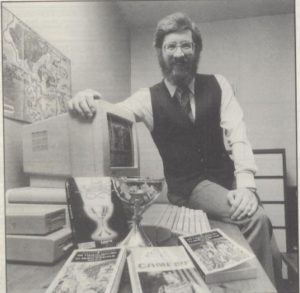
John Sweeney with his freshly won Holy Grail and the things he had to use to win it: his computer, his Lancelot game, and lots and lots of reference books.
I’ll return to the twilight years of the British text-adventure industry in my next article. But for now, for today, a final few words on the three biggest principals behind the original Masquerade, two of them human and one lagomorphic.
Tom Maschler’s Jonathan Cape was purchased by Random House in 1987, becoming an imprint thereof. Maschler stepped down from his role as chief editor shortly thereafter, on the advice of doctors who were warning him of the effect many years of burning the candle at both ends was having on his health. He’s led a quieter life since, emerging publicly only on occasion. In 2005, he published a memoir, called simply Publisher, that garnered mixed reviews. He rates the creation of the Booker Prize as his proudest achievement: “It certainly has had an impact, and if it means people think they should occasionally read a good novel, that is something I’m very proud of.” Amen to that.
Kit Williams tried to capture lightning in a bottle a second time in 1984 via an untitled picture book most commonly referred to as “The Bee Book.” The contest this time was merely to ferret out the book’s real name; no physical treasure was buried. The prize, an intricate art object Williams called a “marquetry box,” was won by one Steve Pearce of Leicester. No rumors of foul play dogged the process this time, but the whole exercise garnered not a shadow of the attention (or sales) of Masquerade, and Kit Williams decided that was enough of that. He returned to the life of a simple painter, becoming more reclusive than ever, creating mostly on personal commission and rarely showing his work publicly.
The whereabouts of the golden hare remained unknown except in rumor for many years. In 2009, however, the thirtieth anniversary of the treasure hunt’s beginning prompted a run of retrospectives in the British media. This attention in turn prompted the hare’s anonymous Asian owner to send it back to its homeland for a time. A BBC film crew captured Kit Williams’s emotional reunion with his most famous creation, which he’d last seen from the audience in Sotheby’s more than twenty years earlier. In 2012, the current owner allowed the Victoria and Albert Museum to publicly display the hare, exactly thirty years after having been so rudely refused permission to do so by Ken Thomas/Dugald Thompson. It had been one hell of a circuitous trip — for the hare itself and for everyone who ever fell under its spell.
(Sources: Most of the sources listed in the previous article apply to this one as well. In addition, there are the Creative Computing of May 1983; Home Computing Weekly of November 22 1983 and June 5 1984; Sinclair User of December 1984, January 1985, March 1985, and October 1987; Crash of January 1985 and October 1985; Computer and Video Games of December 1984 and June 1987; Popular Computing Weekly of August 30 1984 and November 29 1984; Your Sinclair of January 1989; Page 6 of July 1989; Amiga Computing of October 1988. Also see the entry for Hareraiser Finale on the site Games That Weren’t 64.)
